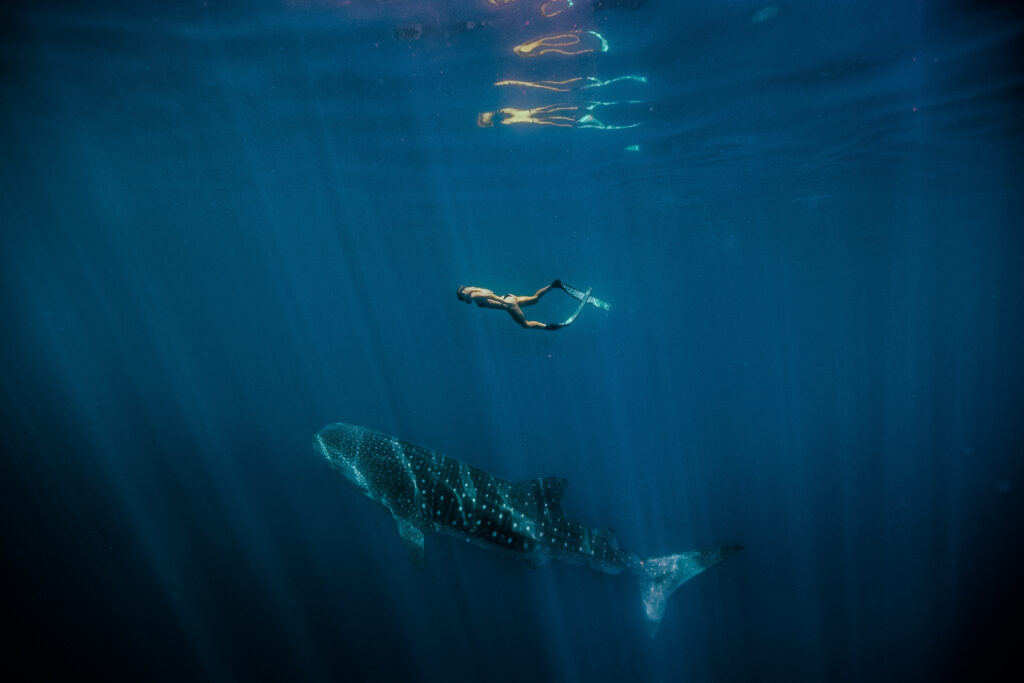

Seeing the sun rise from the depths of the Indian Ocean is worth waking up early for. Swinging lightly in the hammock at the front of my eco-luxe safari tent at Sal Salis, I silently observe black fade to blue, with dusky pink and orange highlights. The colours that warm the sky usher in what promises to be another extraordinary day on the Western Australian coast.

Lying 1,260 kilometres north of Perth, Exmouth, the gateway to Sal Salis, holds no major terrestrial landmarks – in fact, with a population of around 2,800, it doesn’t hold much at all. It’s the coastline and the transient visitors here that are the main attraction – from April to July it’s whale sharks and then humpback whales take over the show, lingering from August to October.
Today, I’m hoping to meet my first whale shark. I know there are no guarantees – nature can be a fickle friend and these sea creatures can dive far deeper than I’m able to go – but the boat captain gives me hope. “You’re in for a great day,” he promises. “There’s a lot of plankton in the water and they had a good number of whale sharks around yesterday – today shouldn’t be any different.”
We hop in the boat and motor to a spot just outside Ningaloo Reef, which runs along the coast, forming a somewhat protective barrier. A profusion of idyllic snorkelling spots punctuate the reef and opportunities for diving and whale-spotting abound in the deeper waters.
We trial our equipment in a cove, slipping into the turquoise water while the guides assess our water competence. Fish dart between the hard corals, shimmering in the sunlight filtering through in gently flickering beams. On a blank patch of sand, a large grouper lies still, camouflaged to the point of becoming a hazy thought of a fish – one you need to blink to see. Black-and-white-striped humbugs peek shyly from their anemone homes and a giant pufferfish flaps its flowery fins, propelling itself under a coral overhang. It’s a lovely scene, but I’m itching to move on to the main event.

With a dedicated spotter plane overhead, it doesn’t take long for our captain to secure a prime position. The boat spotter stands starboard, gazing out to sea. She points to a bulky grey shape near the top of the water. “Whale shark,” she calls, and we rush to see. “There’s another one,” someone else calls, while one of the guides slips into the water, finning towards a whale shark and raising his fist to indicate he’s in position. The first group drops in to join him, while the second lines up, anxious not to miss out.
As the boat circles back for the drop, another whale shark crosses our path. “We’re going to have our own whale shark. Mask on,” says our guide. One by one, we slide into the water, gathering in a huddle in the path of the behemoth. “Now”, she directs, and we duck our heads under to see the enormous creature gliding towards us, it’s oh-so-wide mouth slightly ajar, filtering plankton from the water for morning tea.

As it passes, we swing around to join, kicking alongside, leaving a clear space of three metres – whale sharks are timid and we don’t want to scare it away. This bad boy is moving at a fast clip and the weaker swimmers start losing ground, so the guide calls us in to prepare for a second run.
Again, we drop in to meet one of the enormous visitors. This one is travelling at a more relaxed pace. I can’t tear my eyes away from the grandeur of this denizen of the deep as it gracefully cuts through the water, propelled by the slightest flick of its powerful tail.
Suddenly, I feel a yank on my fin, jolting me out of the moment. I stop dead, wondering if I’ve drifted too close. The guide gently pulls me back and gestures for me to look to the right, where another of the creatures is approaching, making us the meat in a whale shark sandwich. Being wedged between these mammoth marine beings is breathtaking.
We drop into the water time and time again, the group shrinking as people tire. At the end there are only three of us buddied up with a six-metre whale shark and the five hitchhiking remora suckered on to its belly. We swim almost two kilometres in a companionable synchronised formation before the whale shark banks slightly and heads into the depths, leaving us behind, smiles plastered on our faces. The moment may have passed, but like the whale sharks, I’ll plan another migration. Once is simply not enough.
An extraordinary reef, right on our doorstep, and waiting for you to explore. Book your escape today.
